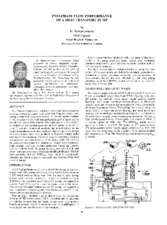| dc.contributor.other | International Pump Users Symposium (14th : 1997) | |
| dc.creator | Samarasekera, H. | |
| dc.date.accessioned | 2017-10-05T16:57:16Z | |
| dc.date.available | 2017-10-05T16:57:16Z | |
| dc.date.issued | 1997 | |
| dc.identifier.uri | https://hdl.handle.net/1969.1/164140 | |
| dc.description | Lecture | en |
| dc.description | pg. 69 | en |
| dc.description.abstract | Heat transport pumps in Canadian deuterium uranium reactor circulate coolant to remove fuel decay heat from the reactor core during normal and accident conditions. A loss-of-coolant-accident is one condition where heat transport pumps play a major role in the safe shut down of the reactor. They must operate under adverse conditions of low suction pressure and two-phase flows for at least 17 minutes. Analytical methods and model testing are no longer acceptable to show this capability. The heat transport pumps for a new reactor have been qualified by full-scale testing under simulated field conditions. The test’s scope covered both vibration and pressure pulsation behavior of the pump under low suction pressures and two-phase flow conditions. Despite high vibrations, shaft runouts and high pressure pulsations during the loss-of-coolant accident tests, the pump bearing, mechanical seal, and motor bearings performed without any significant damage. The test loop geometry and the NSPHavl were found to significantly influence the vibration and pressure pulsation behavior and the heat transport pump. | en |
| dc.format.medium | Electronic | en |
| dc.format.mimetype | application/pdf | |
| dc.language.iso | en | |
| dc.publisher | Texas A&M University. Turbomachinery Laboratories | |
| dc.relation.ispartof | Proceedings of the 14th International Pump Users Symposium | en |
| dc.subject.lcsh | Pumping machinery | en |
| dc.title | Two-Phase Flow Performance Of A Heat Transport Pump | en |
| dc.type.genre | Presentation | en |
| dc.type.material | Text | en |
| dc.identifier.doi | https://doi.org/10.21423/R1SM3R | |


